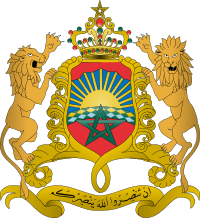Royal Moroccan Armed Forces
| Royal Moroccan Armed Forces 'القوات المسلحة الملكية المغربية'Idwasen Urbiben Igeldanen n Murakucالقوات المسلحة الملكية المغربية | |
|---|---|
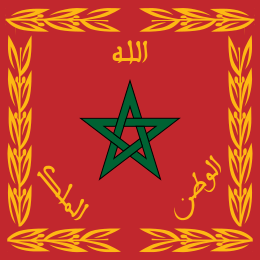 | |
| Founded | active: 1088[1] refounded:14 May 1956 |
| Service branches |
Main branches: |
| Headquarters | Rabat |
| Leadership | |
| Supreme Commander and Chief-of-Staff | King Mohammed VI |
| Minister Delegate for the Administration of National Defense | Abdellatif Loudiyi |
| Inspector General | General Bouchaib Arroub[2] |
| Manpower | |
| Military age | 18 |
| Active personnel | 195,800 (2012)[3] (ranked 26th) |
| Reserve personnel | 150,000 (2012) |
| Expenditures | |
| Budget | 29.4 billion MAD (US$3.37 billion) (2012)[3][4] |
| Percent of GDP | 3.47% |
| Industry | |
| Foreign suppliers |
|
| Related articles | |
| History |
Military history of Morocco Ifni War Sand War Yom Kippur War Western Sahara War Shaba I Gulf War Perejil Island crisis Intervention against ISIL Intervention in Yemen |
The Royal Moroccan Armed Forces (Berber: Idwasen Urbiben Igeldanen n Murakuc; Arabic: القوات المسلحة الملكية المغربية, Al-Quwwat al-Musallaha al-Malakiyah al-Maghribiyah) are the military forces of the Kingdom of Morocco. They consist of the Army, the Navy, the Air Force, the Royal Gendarmerie، and the Royal Guard
The Royal Moroccan Armed Forces are large, expensive and well-trained with extensive experience in counter-insurgency, desert warfare and combined air-land operations. Further experience has come from participating in peace-keeping operations.[3] However, as Morocco has not fought a conventional interstate war since the Algerian-Moroccan war of 1963, they have little experience in state-on-state warfare.[5]
But this force still faces many challenges. The U.S. Embassy in Rabat commented in 2008 that: "The military remains plagued by corruption, an inefficient bureaucracy, low levels of education in the ranks, periodic threats of radicalization of some of its soldiers, political marginalization, and the deployment of most of its forces in Western Sahara".[6]
History
The Moroccan army has existed continuously since the rising of Almoravid Empire in the 11th-century. During the protectorates period (1912–1956),[7] large numbers of Moroccans were recruited for service in the Spahi and Tirailleur regiments of the French Army of Africa (French: Armée d'Afrique). Many served during World War I. During World War II more than 300,000 Moroccan troops (including goumier auxiliaries) served with the Free French forces in North Africa, Italy, France and Austria. The two world conflicts saw Moroccan units earning the nickname of "Todesschwalben" (death swallows) by German soldiers as they showed particular toughness on the battlefield. After the end of World War II, Moroccan troops formed part of the French Far East Expeditionary Corps engaged in the First Indochina War from 1946 to 1954.
The Spanish Army also made extensive use of Moroccan troops recruited in the Spanish Protectorate, during both the Rif War of 1921–26 and the Spanish Civil War of 1936–39. Moroccan Regulares, together with the Spanish Legion, made up Spain's elite Spanish Army of Africa. A para-military gendarmerie, known as the "Mehal-la Jalifianas" and modelled on the French goumieres, was employed within the Spanish Zone.
The Royal Armed Forces were created on 14 May 1956, after the French Protectorate was dissolved.[8] 14,000 Moroccan personnel from the French Army and 10,000 from the Spanish Armed Forces transferred into the newly formed armed forces, this number was augmented by approximately 5,000 former guerrillas from the "Army of Liberation", About 2,000 French officers and NCOs remained in Morocco on short term contracts until the training programs at the military academies of St-Cyr, Toledo and Dar al Bayda produced sufficient numbers of Moroccan commissioned officers.
Four years later, the Royal Moroccan Navy was established in 1960.
The Moroccan military first Engagement as an independent country in the 20th century was the border war of 1963 with Algeria,[9][10][11] In the early 1960s, Moroccan troops were sent to the Congo as part of the first multifunctional UN peacekeeping operation ONUC, The Royal Moroccan Armed Forces fought during the Six-Day War and on the Golan front during the Yom Kippur War of 1973 (mostly in the battle for Quneitra) and intervened decisively in the 1977 conflict known as Shaba I to save Zaire's regime.[12][13][14] After Shaba II, Morocco was part of the Inter-African Force deployed on the Zaire border, contributing about 1,500 troops.[15] The Royal Moroccan Armed Forces also took a symbolic part in the Gulf War among other Arab armies.
But the Moroccan Armed Forces were mostly notable in fighting a 16-year war against the POLISARIO,[16] an Algerian backed rebel national liberation movement seeking the independence of Western Sahara from Morocco, from the mid-1980s Morocco largely managed to keep POLISARIO troops off by building a huge sand wall, staffed by an army roughly the same size as the entire Sahrawi population, enclosing within it the economically useful parts of Western Sahara (Bou Craa, El-Aaiun, Smara etc.). This stalemated the war, with no side able to achieve decisive gains, but artillery strikes and sniping attacks by the guerrillas continued, and Morocco was economically and politically strained by the war.[17]
In the 1990s, Moroccan troops went to Angola with the three UN Angola Verifications Missions, UNAVEM I, UNAVEM II, and UNAVEM III. They were also in Somalia, with UNOSOM I,[18] the U.S.-led Unified Task Force (UNITAF), known by its U.S. codename of 'Restore Hope' and the follow-on UNOSOM II, They saw fighting during the Battle of Mogadishu to rescue a U.S. anti-militia assault force. Other peace support involvement during the 1990s included United Nations Transitional Authority in Cambodia (UNTAC) in Cambodia, and the missions in the former Yugoslavia: IFOR, SFOR, and KFOR.
On 14 July 1999, the Moroccan Armed Forces took part in the Bastille Day parade on the Champs-Élysées, which was exceptional for a non-French armed forces, at the invitation of then French President Jacques Chirac.[19]
Branches
The modern Moroccan military is composed of the following branches :
The Royal Army
The Royal Moroccan Army is the branch of the Royal Moroccan Armed Forces responsible for land-based military operations. The army is about 175,000 troops strong, In case of war or state of siege, an additional force of 150,000 Reservists and paramilitary forces, including 20,000 regulars of the Royal Moroccan Gendarmerie and 30,000 Auxiliary Forces come under the Ministry of Defense command.
Royal Guard
The Moroccan Royal Guard is officially part of the Royal Moroccan Army, However it is under the direct operational control of the Royal Military Household of His Majesty the King, The sole duty of the guard is to provide for the security and safety of the King and royal family of Morocco.
The Royal Air Force
The Royal Moroccan Air Force is the air force branch of the Moroccan Armed Forces, It employs 13,000 personnel and is equipped with more than 300 aircraft, in the 21st century the Royal Moroccan Air Force started a progressive modernization program of its ageing fleet and their technical and operational capacities.
The Royal Navy
The Royal Navy is the branch of the Moroccan Armed Forces responsible of conducting naval operations, Its mission includes the protection of Moroccan territory and sovereignty, as well as the control of Morocco's 81,000 square nautical mile Exclusive Economic Zone. Given Morocco's significant coastline (2,952 km) and strategic position oversseing the strait of Gibraltar, it (with Spain and the United Kingdom) is deeply involved in the security of this important international waterway.
Royal Gendarmerie
The Moroccan Royal Gendarmerie is the Gendarmerie body of Morocco, the legislation which founded the Royal Moroccan Gendarmerie describes it as a public force designed to guarantee public security and public order and the implementation of laws. This legislation text attaches the Gendarmerie to the Royal Moroccan Army, then constituting a military force in its structure, administration and command forms. It consists of officers and NCOs.
Auxiliary Forces
The Moroccan Auxiliary Forces is a paramilitary force legally part of the Royal Moroccan Armed Forces but following the command of the Ministry of the Interior of Morocco, which supplements the military, Gendarmerie and police when needed, Auxiliary Forces' missions are to support security forces and the army, maintain public security, and participate in operational missions of territory defense.
History of participation in peacekeeping operations

Congo 1960-1961
Congo ONUC
Somalia 1992-1994
Somalia UNOSOM I, UNITAF, UNOSOM II
Bosnia and Herzegovina 1996-2007
Bosnia and Herzegovina IFOR, SFOR, EUFOR Althea
Morocco has deployed one company of soldiers[20] to contribute in the NATO-led international peacekeeping force which was responsible for establishing a secure environment in Kosovo.
2004-2006
Haiti MINUSTAH
Democratic Republic of the Congo since 1999
Congo MONUSCO
Morocco has deployed 6 observers, one mechanised infantry battalion and one field hospital[20] to participate in the United Nations Security Council efforts to monitor the peace process of the Second Congo War .
Ivory Coast since 2004
Ivory Coast ONUCI
Morocco has deployed one infantry battalion[20] to participate in the ONUCI peacekeeping mission whose objective is "to facilitate the implementation by the Ivorian parties of the peace agreement signed by them in January 2003" (which aimed to end the Ivorian Civil War). The two main Ivorian parties here are the Ivorian Government forces who control the south of the country, and the New Forces (former rebels), who control the north. The UNOCI mission aims to control a "zone of confidence" across the centre of the country separating the two parties.
Central African Republic since 2013
Central African Republic BINUCA, MINUSCA
The Moroccan Royal Armed Forces Has sent a contingent on December 25, 2013 for the Central African Republic to be deployed in the UN Integrated Peace building Office (BINUCA). Moroccan authorities also said they stand ready to support the Central African Republic in its path toward peace and stability.[21]
Motto
The Royal Moroccan Armed Forces motto, which graces every military base, banner, and ship, is: "God, The Homeland, The King".[22]
- God: Creator of all destiny, by His Mercy we draw from, He ordains our choice to right path.
- The Homeland: Land that begets our bounty, from which we sustain ourselves we protect its integrity and defend it from all enemies.
- King: Our commander and guide, he guides our renaissance and development, protector of our people's rights."
Gallery
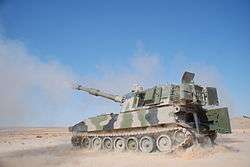 RMA's M109A5 howitzer.
RMA's M109A5 howitzer.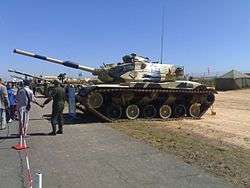 Moroccan M60A3 during a 2006 Army expo.
Moroccan M60A3 during a 2006 Army expo.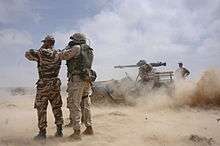 US Marines and Moroccan soldiers during exercise African Lion in Tan tan.
US Marines and Moroccan soldiers during exercise African Lion in Tan tan.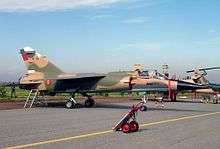 Royal Moroccan Air Force Mirage F1.
Royal Moroccan Air Force Mirage F1.- Floréal Class Mohammed V.
 Royal Moroccan Air Force SA330 Puma.
Royal Moroccan Air Force SA330 Puma.
References
- ↑ http://www.maghreb-observateur.qc.ca/archives98/juillet99/la_garde_royale_marocaine.html
- ↑ "SM le Roi nomme le Général de Corps d'Armée Bouchaib Arroub, Inspecteur général des FAR, Commandant la zone Sud". 2014-06-13. Retrieved 2014-10-03.
- 1 2 3 IISS 2013, pp. 394
- ↑ The SIPRI Military Expenditure Database
- ↑ "Fanack Chronicle - Morocco - The military". Retrieved 2015-02-19.
- ↑ "MOROCCO'S MILITARY: ADEQUATE, MODERNIZING, BUT FACING BIG CHALLENGES". 2008-08-04. Retrieved 2014-10-03.
- ↑ CIA World Factbook
- ↑ "57e anniversaire de la création des FAR". 2014-05-16. Retrieved 2014-10-03.
- ↑ Ifni & After, Time Magazine, December 16, 1957
- ↑ Algerian-Moroccan War 1963 - onwar.com
- ↑ C. Kohn, George. Dictionary of Wars. p. 10.
- ↑ The “Cuba of the West:” France and Mobutu’s Zaïre, 1977-1979
- ↑ National Intelligence Daily (Cable) : 5 June 1978
- ↑ National Intelligence Daily (Cable), 27 novembre 1978
- ↑ Berman, Eric G.; Sams, Katie E. (2000). Peacekeeping In Africa : Capabilities And Culpabilities. Geneva: United Nations Institute for Disarmament Research. pp. 219–220. ISBN 92-9045-133-5.
- ↑ The Sahara War 1975-1991 - onwar.com
- ↑ WESTERN SAHARA - THE FACTS
- ↑ United Nations Operation in Somalia I: facts and figures
- ↑ Le 14 juillet 1999, les Forces armées royales ont défilé sur les Champs-Élysées.
- 1 2 3 IISS 2013, pp. 396
- ↑ UN Secretary General Grateful to Morocco for Action for Stability in Central African Republic
- ↑ Constitution of Morocco, 1992
